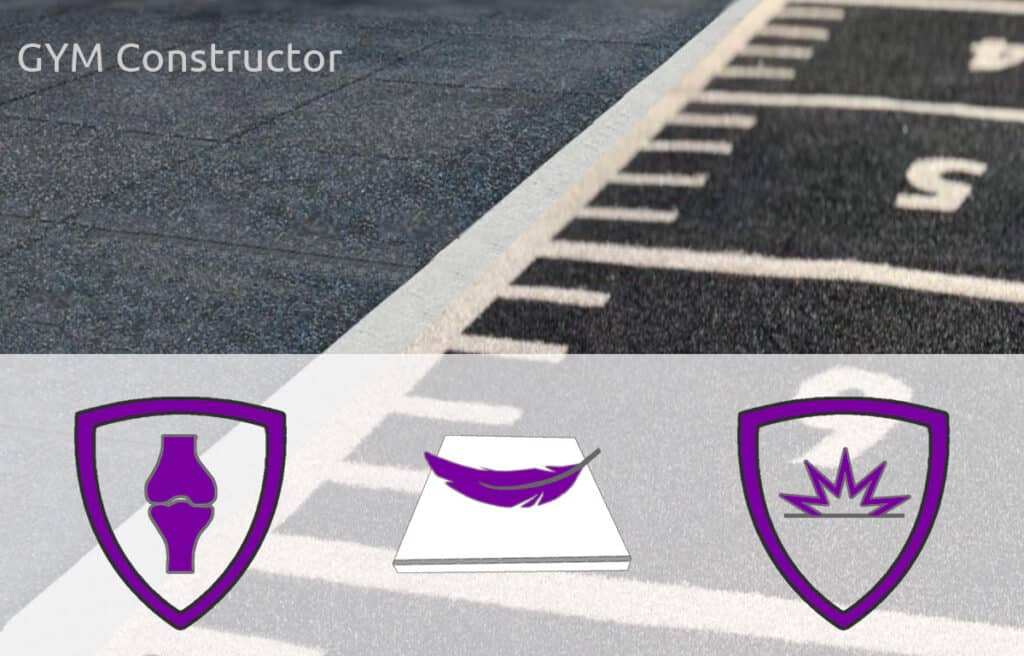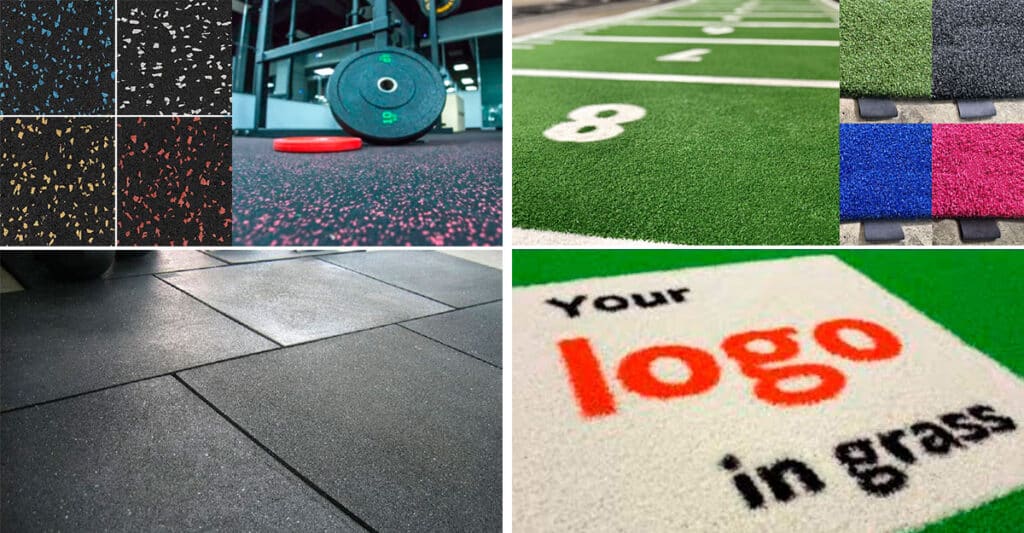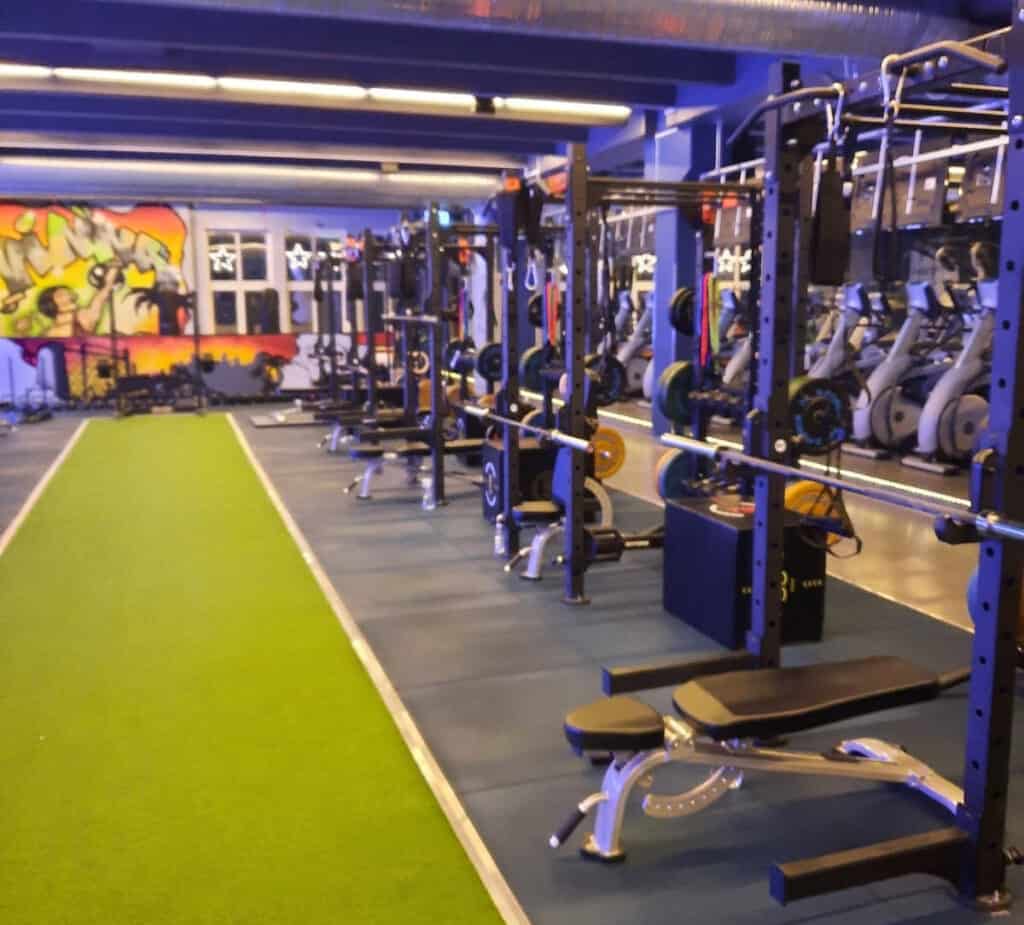A Guide to Selecting the Best Gym Flooring (Intro)
Gym flooring is one of the last things people think about when opening a gym. And if a gym is an additional service, as in a hotel, flooring becomes the last thing for thought and budget.
You have decided to open a gym or a fitness centre, and now you are wondering what gym flooring to use and where.
You have probably visited gyms and seen different types of flooring. There is rubber flooring in tiles and rolls of various thicknesses and textures. You can find artificial grass flooring with speed tracks… So how to choose gym flooring?
We must go through the purposes and functions of gym flooring to choose the best. Then we will proceed with gym flooring personalisation and meeting fire and noise regulations. We will need to comment on installation, maintenance and cleaning. We have considered finishing the article with pricing and calculating the flooring required. So here is what our journey to how choosing gym flooring will look like:
- A Guide to Selecting the Best Gym Flooring (Intro)
- Safety for Athletes and Floor Protection
- Gym Flooring Functionality
- Customisation Options for Gym Flooring and Artificial Turf
- Check Out Noise Regulations in Your Region Before Deciding on Flooring.
- Ask for certificates to comply with fire regulations.
- Gym flooring installation
- Cleaning and maintenance of gym flooring
- Gym flooring prices
- Summary
Safety for Athletes and Floor Protection
Why use gym flooring in the first place?
A gym owner’s first and foremost objective is keeping gym users safe. Show your gym users you care about their safety. The shock absorption quality of flooring helps to protect joints during high-impact training. Increased traction prevents users from slipping and getting injured. Flooring will also soften the impact in case of falling.

Flooring protects concrete floors from heavy equipment impact and serves as a sound and vibration-dampening solution. You don’t want it to leave marks when your client drops something heavy on the floor, like a dumbbell or plate-loaded bar. People will drop weights on the floor wherever free weights are used, as in typical gyms, CrossFit boxes or functional training areas. There is no need to install special platforms for heavy weight-lifting competitions. Although they look nice and provide extra protection to the floor, rubber flooring with the proper thickness will suffice.
Gym Flooring Functionality
Where to put rubber gym flooring?
Take advantage of flooring functionalities to decide which to use. As we mentioned earlier, rubber flooring in tiles is preferable for heavy-weight training. However, it is much easier and less costly to cover an ample space with rubber flooring in rolls when much floor protection is not needed.
Where to put gym turf?
Gym turf is more suitable for functional exercises. Functional exercises are done using our weight or simulating activities we would do in our daily lives.
A current trend is turf-based CrossFit and functional training areas, allowing you to do more exercises with your own body. You don´t necessarily need specific equipment for jumping or running; however, plyo boxes and cones will help you vary training and make it more interesting. In addition, group training such as warm-ups, stretching and HIIT sessions are perfect on artificial grass. Sports flooring surface provides the required softness to jump and sit on while giving a specific, confined space without walls.
Gym owners put artificial turf to use its advantages against other types of flooring. Due to its unique properties, artificial grass provides a perfect grip for acceleration and agility training while giving a sliding effect for large objects, such as a sledge, that can be easily drawn or pushed across thousands of turf fibres. Both softness and traction can be specifically designed for each purpose, and the natural look and feel of the turf transmit the motivation to do sports using our bodies.
How to bring a natural feeling to a gym?
Artificial grass helps you bring a great atmosphere to the gym as its natural look pleases the eye and invites your gym users to do outdoor training inside. Of course, gym turf is also ideally suited for the outdoors.
Can artificial grass for gyms be used outdoors?
Synthetic turf for gyms originates from field hockey, so using it outdoors is a good idea! Many outdoor sports such as football, tennis, golf, rugby, paddle, and other sports benefit from artificial grass features.
What´s the difference between gym turf and the others?
The artificial turf you can find in a gym differs from a football field or paddle club. Multi-sports use intermediate-sized fibres that are not so “curly” as gym turf but are not as straight as football turf. The main aim is to bridge the properties of gym turf with the ones of football turf to enable practising multiple sports such as soccer, tennis, and even basketball, as the name indicates. There are a lot of innovations going on in the turf market, and you can find artificial turf according to your specific needs.
Customisation Options for Gym Flooring and Artificial Turf
Use your logo and colours on artificial grass flooring.
Another substantial benefit is the customisation possibility of gym turf. As fibres with different colours are individually woven into the carpet, they provide a long-term stable fitness floor that can exhibit brand colours and the club logo and strongly support the club’s brand story. You can have a markup on the flooring to designate areas for specific training. For competitive and variation purposes, you might want to have a place of turf flooring with a markup. Integrating functional elements such as speed tracks, agility training elements or group training markings enables artificial turf to become a multifunctional gym flooring solution.
Rubber flooring personalisation
Rubber flooring also has options for customisation. There are various colours for rubber tile flooring but only in the premium segment. The percentage of EPDM rubber in the tiles increases, and thus fewer black spots are achieved, but the price rises. Coloured rubber flooring rolls are also more expensive than just black.

Check Out Noise Regulations in Your Region Before Deciding on Flooring.
How can I make my gym soundproof?
Whether it is dropping weights or using treadmills, these activities are always accompanied by noise, so you must consider making your fitness facility soundproof.
If your gym is not in a stand-alone building, you might receive complaints from the neighbours, and, as always, there are regulations for noise. If you are building a hotel gym, you don’t want your guests disturbed by noises from the gym. Aside from isolating the walls and placing acoustic panels, suitable flooring makes your gym more soundproof. The more you want to reduce the noise level, the thicker flooring you would need to install. The underlayer of a rubber tile flooring may have a special texture to improve sound dampening. Consult flooring suppliers, and according to the building and other parameters, they will suggest appropriate flooring.
Is putting gym turf enough to get rid of noise complaints?
Synthetic turf is a carpet that consists of different layers and reduces noise and vibrations. As gym turf is not customarily used where heavy weights are dropped, there is no need for extra noise reduction, but it can easily be upgraded to meet your creative ideas. You can consult your supplier if noise cancelling is required, mainly if the gym is located in a multi-purpose building or if you have thought of a concept that implies mixing heavy weights and artificial grass. The supplier can suggest adding a specific layer below the turf, like a cork.
Ask for certificates to comply with fire regulations.
What are the regulations regarding fire resistance for flooring?
It is crucial to make sure the flooring you are about to buy for the gym meets fire regulations in your country. For instance, in France, you can only use flooring with a fire classification of C fl, regarded as flame-retardant floor coverings or higher.
Preventing is better than addressing the issue later. Installing gym flooring without the authorities’ prior approval can result in a fine. If the flooring you have purchased does not meet fire regulations, at best, your installation options will be limited, or you will not be able to use it. Avoid putting other people’s lives in danger by trying to save a little money.
Gym flooring installation
What disadvantages does the rubber flooring have?
Rubber flooring tends to shrink over time, and after a couple of years of use or even earlier, you can see that the tiles are a bit separate. You can also see that the corners of the tiles want to go up because of the shrinking of the rubber. Imagine what the flooring will look like in 10 years, and minimise deteriorating effects when choosing and installing it.
How to make gym flooring more durable?
Choosing and making installation properly is vital to diminish the ageing effects on rubber flooring.
The rubber flooring in tiles may have interlocking mechanisms that keep tiles in place and simplify flooring installation. Tiles typically have a pin-and-hole connection on both sides of the tile. This connection forms several rows of tiles joined only within the row and in one direction: north-south or east-west. Over time, tiles in different rows will separate if they are not glued to the floor.
If a tile has interlocking mechanisms on four sides, it is always connected to others in all four directions. The tiles will stay together, and you don’t need to glue them down. This type of tile may be your best option if, due to fire regulations, you cannot glue the flooring or install it from wall to wall. Puzzle tiles flooring is an excellent example of connection in four directions, but there are even more efficient solutions on the market.
How to install rubber flooring tiles?
When installing rubber tile flooring, you always want a retaining edge around the tiles to keep them in place. The best option for these retaining borders would be using walls, but if there are edges with no walls around, you need something to compress the tiles from these sides. In that case, you can put transitional ramps or slides. The ramps usually are glued to the floor to provide that retention effect. In addition, the ramps will gradually level the edges of the tiles with the floor below.
What if I want to change the flooring position?
There is no need to glue the tiles since they have an interlocking mechanism. If you want to change your gym in a couple of years, pick up the tiles and put them elsewhere. You still have the ramps glued, but that is no problem because they can be easily removed.
How to install artificial turf in a gym?
The standard procedure for installing artificial turf includes glueing it to the floor or using double-sided tape. Both variants provide a strong bond that inhibits any movement of the turf with the drawback of additional installation costs and reduced flexibility to adapt the gym concept at a later stage. Recently gym turf with an anti-slip backside has been developed to provide a solid bond to the ground. Though it is slightly more expensive, it saves installation costs and maintains flexibility if you want to relocate the flooring.
Not glueing turf to the floor may have another advantage. If the flooring is glued to the floor, it is considered a part of the building in some countries and is subject to stricter fire regulations. Don´t forget to check with authorities’ fire, sound and vibration regulations before buying flooring and ensure your supplier has appropriate certificates.

Cleaning and maintenance of gym flooring
How to clean rubber flooring?
Rubber flooring is easily cleaned by vacuuming and then mopping. Ensure that the cleaning solution you use is not abrasive for rubber. You can always try on a small area before wet-washing the whole floor. We encourage you to read our more detailed article “How to Clean Gym Flooring: Essential Tips for a Spotless Workout Space“.
Is some rubber flooring easier to clean than others?
Another essential feature of the rubber tiles flooring is coarseness. The less coarse the flooring is, the better it looks and easier to clean. To give you smoother and easier-to-clean flooring, manufacturers usually use different rubber as the top layer of the tile, like EPDM (ethylene propylene diene monomer rubber), which is more expensive.
Gym turf maintenance?
Artificial grass is durable and considered low-maintenance flooring, but it still requires some of your attention. To make your gym turf last longer, brush flattened fibres against the grain to help them get up. A regular broom will do just fine.
If you have placed gym turf outdoors, keep the outside temperature in mind, especially in countries with sweltering summers. You might want to rinse these hot fibres to increase area working hours and make the gym turf last longer.
How to clean artificial grass?
Gym turf is easy to clean it requires very little detergent to remove spillage stains or dry-cleaning solvents. You can clean the turf as a carpet with a regular vacuum cleaner for solid particles.
After the COVID-19 pandemic, antibacterial and antiviral treatment is a necessity. Use disinfecting sprays, and your customers will stay safe and healthy.
Calculating how much flooring is needed and the pricing.
How many tiles do I need to cover 100 m2 of the free weights area?
The number of tiles you need depends on area distribution, tile size and proper installation. Different manufacturers have different tile sizes, and since the area where you want to put flooring is rarely a perfect square, the installation team will have to cut the tiles to fit perfectly. Manufacturers recommend purchasing an additional 10% of tiles than the required space, but you´d better consult your supplier as they usually help with area layouts.
Gym flooring prices
How much does gym flooring cost?
The price range for a generic rubber gym flooring in rolls is about 17 – 50€ per square metre. You can also find more expensive rubber flooring rolls from high-end brands. The thickest rolls we have seen are 10mm.
Rubber flooring in tiles is more expensive than that in rolls. With the more significant, up to 60mm thickness and textures, rubber tiles surely give better shock and sound absorption. Gym turf is sold in rolls, and its pricing varies a lot. Depending on the size of a gym turf roll, fibre density and other characteristics, the price for a square metre can be between 8€ – 40€. Putting additional markup on your brand logo and colours will increase the price.
| Type of flooring | Price per m² |
|---|---|
| Gym turf | 8€ – 40€ |
| Rubber flooring in rolls | 17€ – 50€ |
| Rubber flooring in tiles | 20€ – 90€ |
Summary
There is no unique solution to the gym flooring. In some areas, putting gym turf is better. In other areas, it makes more sense to place rubber flooring.
I hope after we have discussed gym flooring characteristics, functions, customisation, regulations compliance, installation, maintenance and pricing, you will be able to make an informed decision when choosing the best flooring for your gym or sports facility.
As a bonus, here is a short list of questions to have in mind before buying gym flooring:
- What activities my customers will exercise in the gym? It will help you understand which type of flooring you need.
- Is your gym located in a stand-alone building, or are you sharing it? That is how you consider which flooring thickness is adequate for your gym.
- What fire grade is enough for flooring in your country and region? There are installation peculiarities to consider to avoid problems with fire authorities.
- Do I have a floor plan of the premises? With the floor plan, suppliers will figure out the m² required and prevent you from buying excessive flooring.
- Do you need flooring customisation? You can use your logo and colours.
To comment on the article, please proceed to the Telegram post.
Disclaimer: The opinions and positions expressed in this publication are those of the authors and collaborators and do not necessarily reflect the views or policies of the professional fitness community.

